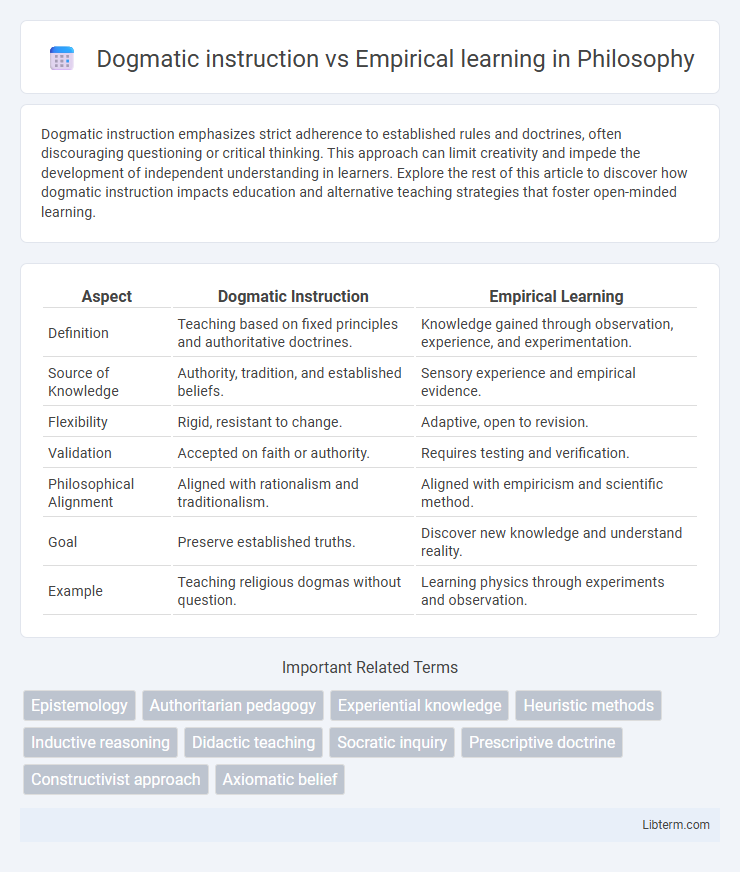Dogmatic instruction emphasizes strict adherence to established rules and doctrines, often discouraging questioning or critical thinking. This approach can limit creativity and impede the development of independent understanding in learners. Explore the rest of this article to discover how dogmatic instruction impacts education and alternative teaching strategies that foster open-minded learning.
Table of Comparison
| Aspect | Dogmatic Instruction | Empirical Learning |
|---|---|---|
| Definition | Teaching based on fixed principles and authoritative doctrines. | Knowledge gained through observation, experience, and experimentation. |
| Source of Knowledge | Authority, tradition, and established beliefs. | Sensory experience and empirical evidence. |
| Flexibility | Rigid, resistant to change. | Adaptive, open to revision. |
| Validation | Accepted on faith or authority. | Requires testing and verification. |
| Philosophical Alignment | Aligned with rationalism and traditionalism. | Aligned with empiricism and scientific method. |
| Goal | Preserve established truths. | Discover new knowledge and understand reality. |
| Example | Teaching religious dogmas without question. | Learning physics through experiments and observation. |
Understanding Dogmatic Instruction
Dogmatic instruction relies on fixed principles and authoritative teachings, emphasizing memorization and adherence over critical thinking or experiential understanding. This method often limits learners' ability to question or explore beyond prescribed knowledge, potentially hindering adaptation and innovation. Understanding dogmatic instruction involves recognizing its rigidity and the potential constraints it imposes on deeper, flexible comprehension.
Defining Empirical Learning
Empirical learning involves acquiring knowledge through observation, experimentation, and experience, emphasizing evidence-based understanding rather than rote memorization. This approach fosters critical thinking and adaptability by encouraging learners to engage actively with real-world data and test hypotheses. Unlike dogmatic instruction, which relies on authoritative assertions, empirical learning prioritizes verification and hands-on exploration to build reliable and practical knowledge.
Historical Roots of Dogmatic Teaching
Dogmatic instruction traces its roots to ancient educational systems where knowledge was transmitted through authoritative texts and rigid doctrines, emphasizing unquestioned acceptance of established truths. This approach dominated medieval scholasticism, with institutions like universities enforcing strict adherence to canonical teachings. Contrastingly, empirical learning emerged during the Scientific Revolution, advocating observation and experimentation as foundations for acquiring knowledge.
Evolution of Empirical Pedagogies
Empirical learning has transformed educational methods by emphasizing observation, experimentation, and hands-on experiences, contrasting sharply with traditional dogmatic instruction rooted in rote memorization and authoritative teaching. The evolution of empirical pedagogies is marked by the integration of scientific inquiry and critical thinking skills, fostering adaptive learning environments tailored to individual student needs. Modern education systems increasingly adopt empirical strategies to enhance engagement, cognitive development, and real-world application, replacing rigid, dogma-based curricula.
Key Differences Between Dogmatic and Empirical Approaches
Dogmatic instruction relies on authoritative teaching and fixed beliefs, emphasizing memorization and acceptance without questioning, while empirical learning is grounded in observation, experimentation, and evidence-based understanding. Dogmatic methods prioritize conformity and tradition, contrasting with the empirical focus on critical thinking, adaptability, and continuous inquiry. The key difference lies in dogmatism's resistance to change versus empirical learning's openness to revision based on new data.
Psychological Impacts on Learners
Dogmatic instruction often leads to reduced critical thinking and increased cognitive rigidity, which can hinder learners' psychological flexibility and creativity. In contrast, empirical learning enhances engagement and motivation by encouraging active exploration, promoting a growth mindset and resilience in the face of challenges. Research in educational psychology shows that learners exposed to empirical methods exhibit improved self-efficacy and adaptability compared to those subjected to dogmatic teaching styles.
Case Studies: Dogmatic vs Empirical Outcomes
Case studies reveal that dogmatic instruction, relying on rigid rules and unchallenged authority, often limits critical thinking and adaptability in learners. Empirical learning, grounded in observation, experimentation, and evidence-based methods, consistently produces higher engagement and deeper understanding, as demonstrated in fields like science education and medical training. Comparative analyses show empirical outcomes yield better problem-solving skills and real-world application, highlighting the effectiveness of experiential learning models over dogmatic approaches.
Relevance in Modern Education Systems
Dogmatic instruction, characterized by rigid adherence to established doctrines, contrasts sharply with empirical learning, which emphasizes observation, experimentation, and evidence-based knowledge. Modern education systems increasingly prioritize empirical learning to foster critical thinking, adaptability, and real-world problem-solving skills essential for a rapidly evolving global landscape. Integration of empirical methods enhances student engagement and better prepares learners for dynamic career demands and technological advancements.
Challenges in Transitioning to Empirical Learning
Transitioning from dogmatic instruction to empirical learning presents challenges such as resistance to change due to ingrained traditional teaching methods and the need for developing critical thinking skills. Educators must adapt curricula to incorporate hands-on experimentation and data analysis, which often requires additional resources and training. Students may initially struggle with the ambiguity and self-directed nature of empirical learning compared to the structured certainty of dogmatic approaches.
Balancing Dogma and Evidence in Contemporary Teaching
Balancing dogmatic instruction with empirical learning in contemporary teaching requires integrating established theoretical frameworks alongside data-driven evidence to foster critical thinking and adaptability. Emphasizing empirical learning encourages students to test hypotheses and learn from observation, while dogmatic instruction provides foundational knowledge and structured guidance. Effective education blends both approaches, ensuring learners develop a robust understanding supported by validated facts and the ability to question and explore new information independently.
Dogmatic instruction Infographic

 libterm.com
libterm.com